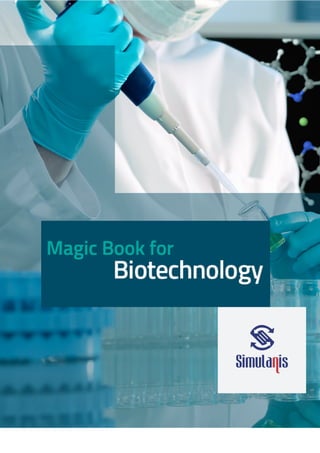
Biotech
- 2. B iotechnology is technology based on biology, especially when used in agriculture, food science, and medicine. The UN Convention on Biological Diversity has come up with one of many definitions of biotechnology: “Biotechnology means any technological application that uses biological systems, living organisms, or derivatives thereof, to make or modify products or processes for specific use.” Traditional pharmaceutical drugs are small chemicals molecules that treat the symptoms of a disease or illness - one molecule directed at a single target. Biopharmaceuticals are large biological molecules known as proteins and these target the underlying mechanisms and pathways of a malady; it is a relatively young industry. They can deal with targets in humans that are not accessible with traditional medicines. A patient typically is dosed with a small molecule via a tablet while a large molecule is typically injected. Small molecules are manufactured by chemistry but large molecules are created by living cells: e.g. bacteria cells, yeast cell, animal cells. Most Important Distinction of Organisms is based on classifying the cells under the below two types: 1. Eukaryotic Cells 2. Prokaryotic Cells The distinction between prokaryotes and eukaryotes is considered to be the most important distinction among groups of organisms. Eukaryotic cells contain membrane-bound organelles, such as the nucleus, while prokaryotic cells do not. Differences in cellular structure of prokaryotes and eukaryotes include the presence of mitochondria and chloroplasts, the cell wall, and the structure of chromosomal DNA. Prokaryotes were the only form of life on Earth for millions of years until more complicated eukaryotic cells came into being through the process of evolution. Introduction to Biotechnology
- 3. DIFFERENCES AND SIMILARITIES BETWEEN THE TWO TYPES OF CELLS: In the next topic we will be discussing about the eukaryotic cell structure in particular. Please find the image of the Nucleus and Eukaryotic Genetic Material in the next section.
- 4. A cell is defined as eukaryotic if it has a membrane-bound nucleus. Any organism composed of eukaryotic cells is also considered a eukaryotic organism. Biologists do not know of any single organism on Earth that is composed of both eukaryotic and prokaryotic cells. However, many different types of prokaryotic cells, usually bacteria, can live inside larger eukaryotic organisms. Creepy, but true. We humans, for example, have trillions of bacteria living in our colons, not to mention in our mouths and stomachs and small intestines and…you get the picture. Despite the fact that we have gobs of prokaryotic cells living inside and on us, humans are still categorically eukaryotic organisms. Deal with it. This means that all human cells, including those found in the brain, the heart, the muscles, and so on, are also eukaryotic. Please find below the AR image of the Eukaryotic cell below to give you an idea how the eukaryotic cell looks like. You may scan the image using the android application to give you an enhanced and 3D view of the cell. Eukaryotic Cell Structure Here are some examples of eukaryotes: • Animals • Plants • Fungi (mushrooms, etc.) • Protists (algae, plankton, etc.) All eukaryotic cells have 1. A nucleus 2. Genetic material 3. A plasma membrane 4. Ribosomes 5. Cytoplasm, including the cytoskeleton
- 5. Most eukaryotic cells also have other membrane-bound internal structures called organelles. Organelles include 1. Mitochondria 2. Golgi bodies 3. Lysosomes 4. Endoplasmic reticulum 5. Vesicles Introduction to DNA STRUCTURE To give a brief introduction to DNA structure, let us first know what DNA is exactly. Well, DNA is a polymer. The monomer units of DNA are nucleotides, and the polymer is known as a "polynucleotide." Each nucleotide consists of a 5-carbon sugar (deoxyribose), a nitrogen containing base attached to the sugar, and a phosphate group. There are four different types of nucleotides found in DNA, differing only in the nitrogenous base. The four nucleotides are given one letter abbreviations as shorthand for the four bases. • A is for adenine • G is for guanine • C is for cytosine • T is for thymine So any guesses what the full-for of DNA is? Well absolutely right. Its full form is Deoxyribonucelic acid. Interestingly it is amusing, that an acid forms the most important part of our lives and the ones around us. A more descriptive image of DNA structure is displayed below, with the nucleotide pairings: In conclusion, throughout human history, we have learned a great deal about the different organisms that our ancestors used so effectively. The marked increase in our understanding of these organisms and their cell products gains us the ability to control the many functions of various cells and organisms. Using the techniques of gene splicing and recombinant DNA technology, we can now actually combine the genetic elements of two or more living cells. Functioning lengths of DNA can be taken from one organism and placed into the cells of another organism. As a result, for example, we can cause bacterial cells to produce human molecules. Cows can produce more milk for the same amount of feed. And we can synthesize therapeutic molecules that have never before existed. Let us now take a sneak peek into the DNA structure which will be the focus for the next volume. In this volume get a chance to analyse the diagram using the innovative AR application and get ready to see the wonders work.
- 6. To subscribe, please send your request with your address label to: C-4, Lajpat Nagar III Tel: +91 11 29835004 Fax: +91 11 41017922 Web: www.simulanis.com Email: support@simulanis.com 2015 -Vol. 01 to be continued Demo Version
